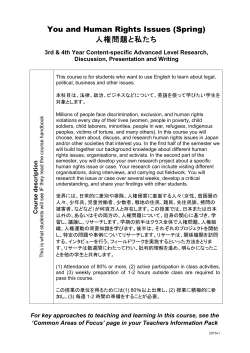
- U
AP Calculus BC Mr. Palmer Syllabus 2014/2015 Email: RyanPalmer@u-46.org Phone: 630-372-4700 x4770 Overview Calculus is the mathematical science of change. Following the BC curriculum set by the College Board, the course is naturally divided into four sections: properties of functions and the notion of a limit, differentiation (rate of change), integration (accumulation of change), and polynomial approximations and series. You will be challenged to work harder than ever in order to succeed at learning calculus. The ultimate goal of this class is to prepare all students to be successful on the AP exam in May. Methodology This course will be implemented using the “Rule of Four.” The four methods of interacting graphically, numerically, analytically, and verbally with the calculus topics listed below will be used throughout the course. We will explore the relationships between each method. Some concepts will be shown briefly using these methods, while other concepts will use all four methods in a detailed manner. Expectations Respect your classmates and their property and respect the purpose for being here. Listen to what I say because every word is important. Follow instructions and ask questions often. Be in your seat when the bell rings before AND after class. The bell does NOT dismiss you… I do. Participate in classroom activities. This includes working with others, taking organized notes, and completing homework. Accept the consequences for the choices you make. CARE about this class. Take responsibility for your learning AND encourage the learning of others. Help classmates when THEY are struggling and accept help from classmates when YOU are struggling. NEVER have electronic devices out unless specifically requested. Required Materials Calculus textbook (AP 9th Edition by Larson & Edwards) 3-ring binder or notebook/folder Pencil and red pen Loose-leaf paper and graph paper GRAPHING calculator (TI-83/84 or TI n-spire recommended) You will be expected to come to class each day prepared with your textbook, binder or notebook/folder, calculator, pencil, and an open mind. To help prepare you for the AP exam, most tests will have both calculator and non-calculator portions. No sharing of calculators will be permitted – you must have your own! Also and most importantly, all work must be done in PENCIL. This includes homework, quizzes, and tests. Assessments This course will operate on a Standards-Based grading system. Each semester will have around 20-30 standards. Writing assignments, lab activities, homework problems, projects, quizzes, and tests will be given to assess your progress on these standards. Writing assignments will be used to practice the art of communicating mathematical ideas through writing. Lab activities will be used to develop graphing calculator skills necessary to discover major ideas. Homework problems will be assigned to reinforce and expand upon material covered in class. Projects will be employed to further your understanding of the fundamental topics. Finally, quizzes and tests will be used the majority of the time to evaluate your mastery of calculus. Each individual problem is graded on a 0-4 scale as described below. After at least two assessments have been given on a particular standard, that standard then gets a grade on a 0-4 scale. Standards will be reassessed continuously throughout the semester to ensure that you are retaining information. You are also allowed to reassess any standards on your own, provided that you fill out a reassessment form and meet the necessary requirements. 4 – Shows complete understanding of the problem. One minor computation error is allowed. 3 – Shows nearly complete understanding of the problem OR makes computational errors. 2 – Shows minimal understanding of the problem OR makes serious computational errors. 1 – Does not understand the problem but shows work that could be relevant. 0 – Blank or completely unrelated work. Homework As this is a college-level class, homework is YOUR responsibility to complete each and every day. Homework will not be collected on a daily basis, but the completion of homework will be CRUCIAL to your success in this class. You will NOT be allowed to reassess on a standard if the homework for that standard is not complete. Attendance If you are absent, it is YOUR responsibility to get assignments and make up notes from either a classmate or myself. In case of absences, you will be given two school days for every missed day to make up missed graded work. After that, all missed work will earn a grade of 0. Extra Help I will be available for help each day during 4th, 5th, and 6th periods. I will also be available most days before or after school. Please see me if you need extra help – but please let me know you’re coming! Website I will keep an ongoing website that will contain all class notes as PDFs, homework assignments, and any other important handouts. The URL for this website is: http://schools.u-46.org/index.pl?id=137082 Grades At the end of the semester you will get an overall standards grade based on the Standards Grading Chart on the next page. You will also be required to take a final exam. Your semester grade is determined by your standards grade and your final exam grade by using the table on the next page. Grade A B C D E 0 1 None allowed None allowed 1 or less 15 Standards 2 3 4 2 or less 9 or more (10% of 15 standards) (60% of 15 standards) 2 or less 9 or more (10% of 15 standards) (60% of 15 standards) 12 or more (5% of 15 standards) (80% of 15 standards) 1 or less 3 or more (7.5% of 15 standards) (20% of 15 standards) 2 or more 13 or less (10% of 15 standards) (90% of 15 standards) Semester Grade Final Exam Grade Standards Grade Standards Grading Chart A B C D E A A A A B B B A B B B C C B C C C D D C C D D E E D D E E E There are three BIG standards, AI-2, S-1, and R-1. In addition to the above requirements… In order to receive an A overall, all BIG standards must be at a 3 or higher. In order to receive a B overall, all BIG standards must be at a 2 or higher. In order to receive a C overall, all BIG standards must be at a 1 or higher. Semester 2 Standards Unit 6: Applications of Integration AI-1 Area between Curves AI-2 Volume AI-3* Arc Length AI-4 Rectilinear Motion II Unit 7*: Techniques of Integration TI-1* Integration by Parts TI-2* Integration by Partial Fractions TI-3* L’Hopital’s Rule TI-4* Improper Integrals Unit 8*: Infinite Series S-1* Convergence and Divergence S-2* Taylor Polynomials S-3* Convergence of Power Series S-4* Manipulating Power Series Unit 9*: Parametric, Vector, and Polar Functions F-1* Parametric and Vector Functions F-2* Polar Functions Unit 10: AP Exam Preparation R-1 Reflection * indicates a BC-specific standard BOLD indicates a BIG standard
© Copyright 2025












